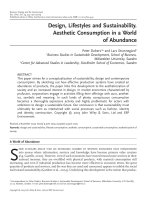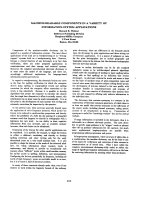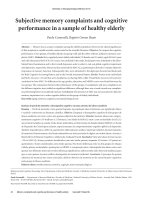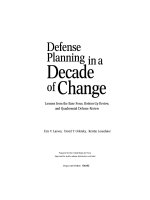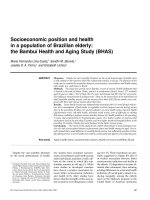architecture in a climate of change
Bạn đang xem bản rút gọn của tài liệu. Xem và tải ngay bản đầy đủ của tài liệu tại đây (6.33 MB, 295 trang )
Architecture in a Climate of Change
AIAC-FM 03/29/2005 17:25 Page i
AIAC-FM 03/29/2005 17:25 Page ii
Architecture in a Climate
of Change
A guide to sustainable design
Peter F. Smith
AMSTERDAM
•
BOSTON
•
HEIDELBERG
•
LONDON
•
NEW YORK
•
OXFORD
PARIS
•
SAN DIEGO
•
SAN FRANCISCO
•
SINGAPORE
•
SYDNEY
•
TOKYO
Architectural Press is an imprint of Elsevier
AIAC-FM 03/29/2005 17:25 Page iii
Architectural Press
An imprint of Elsevier
Linacre House, Jordan Hill, Oxford OX2 8DP
30 Corporate Drive, Burlington, MA 01803
First published 2001
Second edition 2005
Copyright © 2001, 2005, Peter F. Smith. All rights reserved
The right of Peter F. Smith to be identified as the author of this work have been asserted in accordance with the
Copyright, Designs, and Patents Act 1988
No part of this publication may be reproduced in any material form (including photocopying or storing in any
medium by electronic means and whether or not transiently or incidentally to some other use of this publication)
without the written permission of the copyright holder except in accordance with the provision of the Copyright,
Designs, and Patents Act 1988 or under the terms of a licence issued by the Copyright Licensing Agency Ltd, 90
Tottenham Court Road, London, England W1T 4LP. Applications for the copyright holder’s written permission to
reproduce any part of this publication should be addressed to the publisher.
Permissions may be sought directly from Elsevier’ Science and Technology Rights Department in Oxford, UK:
phone: (ϩ44) (0) 1865 843830; fax: (ϩ44) (0) 1865 853333; e-mail: You may also
complete your request on-line via the Elsevier homepage (), by selecting “Customer
Support” and then “Obtaining Permissions”.
British Library Cataloguing in Publication Data
A catalogue record for this book is available from the British Library
ISBN 0 7506 65440
Typeset by Newgen Imaging Systems Pvt Ltd, Chennai, India
Printed and bound in Great Britain
For information on all Architectural Press publication
visit our web site at
AIAC-FM 03/29/2005 17:25 Page iv
Contents
v
Foreword xi
Acknowledgements xii
Introduction xiii
1 Climate change – nature or human nature? 1
The carbon cycle 1
The greenhouse effect 2
Climate change – the paleoclimate record 3
Causes of climate fluctuation 4
The evidence 7
2 Predictions 12
Recent uncertainties 17
What is being done? 19
The outlook for energy 20
The nuclear option 23
3 Renewable technologies – the marine environment 26
The UK energy picture 26
Energy from rivers and seas 28
Hydroelectric generation 28
Small-scale hydro 29
‘Run of river’ systems 29
Tidal energy 30
4 Renewable technologies – the wider spectrum 42
Passive solar energy 42
Active solar 42
Solar thermal electricity 43
The parabolic solar thermal concentrator 44
Photovoltaics 45
Wind power 45
Biomass and waste utilisation 47
AIAC-FM 03/29/2005 17:25 Page v
Hydrogen 50
Nuclear power 50
5 Low energy techniques for housing 52
Construction systems 52
Solar design 54
Types of solar thermal collector 62
Windows and glazing 64
6 Insulation 68
The range of insulation options 69
High and superinsulation 72
Transparent insulation materials 77
Insulation – the technical risks 77
7 Domestic energy 80
Photovoltaic systems 80
Micro-combined heat and power (CHP) 87
Fuel cells 90
Embodied energy and materials 91
8 Advanced and ultra-low energy houses 93
The Beddington Zero Energy Development – BedZED 94
The David Wilson Millennium Eco-House 94
Demonstration House for the Future, South Wales 95
The prospects for wood 98
The external environment 103
Summary checklist for the energy efficient
design of dwellings 104
Report by Arup Research and Development for the
DTI’s Partners in Innovation Programme 2004 107
9 Harvesting wind and water 108
Small wind turbines 108
Types of small-scale wind turbine 110
Building integrated systems 114
Conservation of water in housing 115
Domestic appliances 117
10 Existing housing: a challenge and opportunity 118
The remedy 121
Case study 122
11 Low energy techniques for non-domestic buildings 127
Design principles 127
Environmental considerations in the design of offices 128
Passive solar design 129
CONTENTS
vi
AIAC-FM 03/29/2005 17:25 Page vi
12 Ventilation 138
Natural ventilation 138
Internal air flow and ventilation 138
Unassisted natural ventilation 140
Mechanically assisted ventilation 145
Cooling strategies 151
Evaporative cooling 152
Additional cooling strategies 154
The ecological tower 154
Summary 160
Air conditioning 161
13 Energy options 162
The fuel cell 163
Proton exchange membrane fuel cell 164
Phosphoric acid fuel cell (PAFC) 165
Solid oxide fuel cell (SOFC) 165
Alkaline fuel cell (AFC) 166
Moltel carbonate fuel cell (MCFC) 166
Storage techniques – electricity 169
Photovoltaic applications 170
Heat pumps 171
Energy storage – heating and cooling 174
Seasonal energy storage 176
Electricity storage 177
Building management systems 178
Tools for environmental design 179
Report by Arup Research and Development
for the DTI’s Partners in Innovation
Programme 2004 180
14 Lighting – designing for daylight 181
Design considerations 182
The atrium 184
Light shelves 185
Prismatic glazing 185
Light pipes 185
Holographic glazing 187
Solar shading 187
15 Lighting – and human failings 188
Photoelectric control 189
Glare 190
Dimming control and occupancy sensing 190
Switches 191
System management 191
CONTENTS
vii
AIAC-FM 03/29/2005 17:25 Page vii
Air conditioned offices 192
Lighting – conditions for success 192
Summary of design considerations 193
16 Cautionary notes 195
Why do things go wrong? 195
High profile/low profile 196
The ‘high-tech demand’ 196
Operational difficulties 197
Building related illness 197
Inherent inefficiencies 197
Common architectural problems 198
Common engineering problems 198
Avoiding air conditioning – the issues 198
Common failures leading to energy waste 199
The human factor 199
Summary of recommendations 200
Conclusions 200
17 Life-cycle assessment and recycling 202
Waste disposal 202
Recycling 203
Life-cycle assessment 205
Whole life costing 205
Eco-materials 206
External finishes 207
Paints 207
Materials and embodied energy 208
Low energy Conference Centre, Earth Centre,
Doncaster 209
Recycling strategy checklist 211
18 State of the art case studies 212
The National Assembly for Wales 212
Zuckermann Institute for Connective Environmental
Research (ZICER) 214
Social housing 217
Beaufort Court, Lillie Road, Fulham, London, 2003 217
Beddington Zero Energy Development (BedZED) 218
Beaufort court renewable energy centre zero
emissions building 225
19 Integrated district environmental design 235
Ecological City of Tomorrow, Malmo, Sweden 236
Towards the less unsustainable city 238
CONTENTS
viii
AIAC-FM 03/29/2005 17:25 Page viii
20 An American perspective 245
Glenwood Park, Atlanta, Georgia 248
21 Emergent technologies and future prospects 250
Energy for the future 251
Next generation solar cells 254
Artificial photosynthesis 256
Energy storage 256
Hydrogen storage 257
Flywheel technology 257
Advances in lighting 258
The photonic revolution 259
Smart materials 260
Smart fluids 261
Socio-economic factors 262
Appendix 1 Key indicators for sustainable design 265
Appendix 2 An outline sustainability syllabus for designers 267
Index 275
CONTENTS
ix
AIAC-FM 03/29/2005 17:25 Page ix
AIAC-FM 03/29/2005 17:25 Page x
Foreword
This updated book is essential reading especially as it considers the
‘why’ as well as the ‘what’ of sustainable architecture. There is now wide
agreement that halting global warming and its climatic consequences
is likely to be the greatest challenge that we shall face in this century. As
populations increase and, at the same time, gravitate to cities, build-
ings old and new should be a prime target in the battle to reverse the
demand for fossil-based energy.
Students and practitioners alike within the construction industry
need to be aware of the importance of their role in creating architecture
which not only raises the quality of life but also ensures that such quality
is sustainable.
Lord Rogers of Riverside
xi
AIAC-FM 03/29/2005 17:25 Page xi
Acknowledgements
I should like to express my thanks to the following practices for their
help in providing illustrations and commenting on the text: Bennetts
Associates, Bill Dunster Architects, Foster and Partners, Michael
Hopkins and Partners, Jestico ϩ Whiles, RMJM, Richard Rogers
Partnership, Alan Short Architects, Fielden Clegg Bradley, Studio E
Architects, David Hammond Architects, Grimshaw Architects Ove Arup
and Partners.
I am also indebted to Dr Randall Thomas for his valuable advice on
the text, Dr William Bordass for providing information from his ‘Probe’
studies, Dr Adrian Pitts of Sheffield University, Nick White of the
Hockerton Housing Project, Ray Morgan of Woking Borough Council
and finally Rick Wilberforce of Pilkington plc for keeping me up to date
with developments in glazing.
xii
AIAC-FM 03/29/2005 17:25 Page xii
Introduction
This book calls for changes in the way we build. For change to be widely
accepted there have to be convincing reasons why long-established prac-
tices should be replaced. The first part of the book seeks to set out those
reasons by arguing that there is convincing evidence that climate changes
now under way are primarily due to human activity in releasing carbon
dioxide (CO
2
) into the atmosphere. Buildings are particularly implicated in
this process, being presently responsible for about 47 per cent of carbon
dioxide emissions across the 25 nations of the European Union. This
being the case it is appropriate that the design and construction of build-
ings should be a prime factor in the drive to mitigate the effects of climate
change.
One of the guiding principles in the production of buildings is that
of integrated design, meaning that there is a constructive dialogue
between architects and services engineers at the inception of a project.
The book is designed to promote a creative partnership between the
professions to produce buildings which achieve optimum conditions
for their inhabitants whilst making minimum demands on fossil-based
energy.
A difficulty encountered by many architects is that of persuading
clients of the importance of buildings in the overall strategy to reduce
carbon dioxide emissions. The first chapters of the book explain the
mechanism of the greenhouse effect and then summarise the present
situation vis-à-vis global warming and climate change. This is followed
by an outline of the international efforts to curb the rise in greenhouse
gases. The purpose is to equip designers with persuasive arguments as
to why this approach to architecture is a vital element in the battle to
avoid the worst excesses of climate change.
At the same time it is important to appreciate that there are
absolute limits to the availability of fossil fuels, a problem that will
gather momentum as developing countries like China and India main-
tain their dramatic rates of economic growth.
China may well serve to give a foretaste of the future. By 2005
it had reached 1.3 billion population; at this rate by 2030 it will reach
1.6 billion. The crucial factor is that the great bulk of this population is
concentrated in the great valleys of the Yangtze and Yellow Rivers and
xiii
AIAC-FM 03/29/2005 17:25 Page xiii
their tributaries, an area about the size of the USA. China is on the
verge of consuming more than it can produce. By 2025 it will be import-
ing 175 million tonnes of grain per year and by 2030 200 million tonnes,
which equals present total world exports (US National Intelligence
Council). Its appetite for steel and building materials is voracious and
already pushing up world prices.
A supply of energy sufficient to match the rate of economic growth
is China’s prime concern. Between January and April 2004 demand for
energy rose 16 per cent. In 2003 it spent £13 billion on hydroelectric,
coal fired and nuclear power plants – a rate of expansion that equals
Britain’s entire electrical output every two years. According to a
spokesman for the Academy of Engineering of China, the country will
need an additional supply equivalent to four more Three Gorges hydro-
electric dams, 26 Yanzhou coal mines, six new oil fields, eight gas
pipelines, 20 nuclear power stations and 400 thermal power generators.
Carbon has been slowly locked in the earth over millions of years
creating massive fossil reserves. The problem is that these reserves of
carbon are being released as carbon dioxide into the atmosphere at a
rate unprecedented in the paleoclimatic record. The pre-industrial
atmospheric concentration of CO
2
was around 270 parts per million by
volume (ppmv). Today it is approximately 380 ppmv and is rising by
about 20 ppmv per decade. The aim of the scientific community is that
we should stabilise atmospheric CO
2
at under 500 ppmv by 2050
acknowledging that this total will nevertheless cause severe climate
damage. However, if the present trend is maintained we could expect
concentrations exceeding 800 ppmv by the second half of the century.
Given the absence of a political consensus following the refusal of the
US to ratify the Kyoto Protocol, the 800 plus figure looks ever more
likely unless there are widespread and radical strategies that bypass
political agreements, and this is where architects and engineers have a
crucial part to play.
The Earth receives annually energy from the sun equivalent to
178 000 terawatt years which is around 15 000 times the present world-
wide energy consumption. Of that, 30 per cent is reflected back into
space, 50 per cent is absorbed and re-radiated, and 20 per cent powers
the hydrological cycle. Only 0.6 per cent powers photosynthesis from
which all life derives and which created our reserves of fossil fuel. The
security of the planet rests on our ability and willingness to use this free
energy without creating unsavoury side effects, like the range of pollu-
tants released by the burning of fossil fuels. The greatest potential for
realising this change lies in the sphere of buildings, which, in the UK,
account for almost 50 per cent of all CO
2
emissions. The technology
exists to cut this by half in both new and existing buildings. Already
demonstration projects have proved that reductions can reach 80–90
per cent against the current norm. The opportunity rests with architects
and services engineers to bring about this step-change in the way
buildings are designed. In the 1960s–1970s buildings were symbols
INTRODUCTION
xiv
AIAC-FM 03/29/2005 17:25 Page xiv
of human hubris, challenging nature at every step. The turn of the
millennium saw a new attitude gathering momentum in a synergy
between human activity and the forces of nature. Nowhere can this be
better demonstrated than in the design of buildings.
In 2000 the Royal Commission on Environmental Pollution pro-
duced a report on Energy – The Changing Climate. It concludes: ‘To
limit the damage beyond that which is already in train, large reductions
of global emissions will be necessary during this century and the next.
Strong and effective action has to start immediately.’
Peter F. Smith
January 2005
INTRODUCTION
xv
AIAC-FM 03/29/2005 17:25 Page xv
AIAC-FM 03/29/2005 17:25 Page xvi
Chapter
One
1
Climate change – nature or
human nature?
The key question is this: climate change is now widely accepted as
being a reality, so, is it a natural process in a sequence of climate
changes that have occurred over the paleoclimatic record or is it being
driven by humans? If we hold to the former view then all we can hope
for is to adapt as best we can to the climate disruption. On the other
hand, if we accept that it is largely human induced, then it follows that
we ought to be able to do something about it.
There is widespread agreement among climate scientists worldwide
that the present clear evidence of climate change is 90 per cent certain
to be due to human activity mainly though the burning of fossil-based
energy. This should be good enough to persuade us that human action
can ultimately put a brake on the progress of global warming and its
climate consequences.
Once the issues are understood, a commitment to renewable
energy sources and bioclimatic architectural design should become
unavoidable. Inspiring that commitment is the purpose of the first part
of the book which then goes on to illustrate the kind of architecture that
will have to happen as part of a broader campaign to avert the apoca-
lyptic prospect of catastrophic climate change.
The carbon cycle
Carbon is the key element for life on Earth. Compounds of the element
form the basis of plants, animals and micro-organisms. Carbon com-
pounds in the atmosphere play a major part in ensuring that the planet
is warm enough to support its rich diversity of life.
The mechanism of the carbon cycle operates on the basis that the
carbon locked in plants and animals is gradually released into the
atmosphere after they die and decompose. This atmospheric carbon is
then taken up by plants which convert carbon dioxide (CO
2
) into stems,
trunks, leaves, etc. through photosynthesis. The carbon then enters the
food chain as the plants are eaten by animals.
There is also a geochemical component to the cycle mainly
consisting of deep ocean water and rocks. The former is estimated to
AIAC-Ch01.qxd 03/25/2005 17:08 Page 1
contain 36 billion tonnes and the latter 75 million billion tonnes of
carbon. Volcanic eruptions and the weathering of rocks release this
carbon at a relatively slow rate.
Under natural conditions the release of carbon into the atmos-
phere is balanced by the absorption of CO
2
by plants. The system is in
equilibrium, or would be if it were not for human interference.
The main human activity responsible for overturning the balance of
the carbon cycle is the burning of fossil fuels which adds a further 6 billion
tonnes of carbon to the atmosphere over and above the natural flux each
year. In addition, when forests are converted to cropland the carbon in
the vegetation is oxidised through burning and decomposition. Soil
cultivation and erosion add further carbon dioxide to the atmosphere.
If fossil fuels are burnt and vegetation continues to be destroyed at
the present rate, the CO
2
in the atmosphere will treble by 2100. Even if
there is decisive action on a global scale to reduce carbon emissions,
atmospheric concentrations will still double by this date.
With the present fuel mix, every kilowatt hour of electricity used in
the UK releases one kilogram of CO
2
. The burning of one hectare of
forest gives off between 300 and 700 tonnes of CO
2
.
These are some of the factors which account for the serious imbal-
ance within the carbon cycle which is forcing the pace of the green-
house effect which, in turn, is pushing up global temperatures.
The greenhouse effect
A variety of gases collaborate to form a canopy over the Earth which
causes some solar radiation to be reflected back from the atmosphere,
thus warming the Earth’s surface, hence the greenhouse analogy. The
greenhouse effect is caused by long-wave radiation being reflected by
the Earth back into the atmosphere and then reflected back by trace
gases in the cooler upper atmosphere, thus causing additional
warming of the Earth’s surface (Figure 1.1).
The main greenhouse gases are water vapour, carbon dioxide,
methane, nitrous oxide and tropospheric ozone (the troposphere is the
lowest 10–15 kilometres of the atmosphere).
The sun provides the energy which drives weather and climate. Of
the solar radiation which reaches the Earth, one third is reflected back
into space and the remainder is absorbed by the land, biota, oceans,
ice caps and the atmosphere. Under natural conditions the solar energy
absorbed by these features is balanced by outgoing radiation from the
Earth and atmosphere. This terrestrial radiation in the form of long-
wave, infra-red energy is determined by the temperature of the Earth-
atmosphere system. The balance between radiation and absorption
can change due to natural causes such as the 11-year solar cycle.
Without the greenhouse shield the Earth would be 33ЊC cooler, with
obvious consequences for life on the planet.
ARCHITECTURE IN A CLIMATE OF CHANGE
2
AIAC-Ch01.qxd 03/25/2005 17:08 Page 2
Since the industrial revolution, the combustion of fossil fuels and
deforestation has resulted in an increase of 26 per cent in carbon
dioxide concentrations in the atmosphere. In addition, rising popula-
tion in the less developed countries has led to a doubling of methane
emissions from rice fields, cattle and the burning of biomass. Methane
is a much more powerful greenhouse gas than carbon dioxide. Nitrous
oxide emissions have increased by 8 per cent since pre-industrial times
(IPCC 1992).
Climate change – the paleoclimate record
In June 1990 scientists were brought up sharp by a graph which
appeared in the journal Nature (Figure 1.2). It was evidence from ice
core samples which showed a remarkably close correlation between
temperature and concentrations of CO
2
in the atmosphere from
160 000 years ago until 1989. It also revealed that present concentra-
tions of CO
2
are higher than at any time over that period. Since then the
rate of increase has, at the very least, been maintained.
Ice core samples give information in four ways. First, their melt
layers provide an indication of the time span covered by the core.
Second, a measurement of the extent to which ice melted and refroze
after a given summer gives a picture of the relative warmth of that sum-
mer. A third indicator is the heavy oxygen isotope
18
O in air trapped in
the ice. It is more abundant in warm years. Finally, the air trapped in the
snow layers gives a measurement of the CO
2
in the atmosphere in a
Figure 1.1
The greenhouse ‘blanket’
CLIMATE CHANGE – NATURE OR HUMAN NATURE?
3
Earth’s surface
a year
AIAC-Ch01.qxd 03/25/2005 17:08 Page 3
given year. Other data from ice cores show that, at the peak of the last
ice age 20 000 years ago, sea level was about 150 m lower than today.
Another source of what is called ‘proxy’ evidence comes from
analysing tree rings. This can give a snapshot of climate going back 6000
years. Each tree ring records one year of growth and the size of each ring
offers a reliable indication of that year’s climate. The thicker the ring, the
more favourable the climate to growth. In northern latitudes warmth is
the decisive factor. Some of the best data come from within the Arctic
Circle where pine logs provide a 6000-year record.
The Climate Research Unit of the University of East Anglia has made
a special study of the evidence for climate changes from different sources
and has concluded that there is a close affinity between ice core evi-
dence and that obtained from tree rings. Also instrumental records going
back to the sixteenth century are consistent with the proxy evidence.
Causes of climate fluctuation
To be able to see the current changes in climate in context, it will be
necessary to consider the causes of dramatic changes in the past.
A major cause of climate fluctuation has been the variation in the
Earth’s axial tilt and the path of its orbit round the sun. The Earth is
subject to the influence of neighbouring planets. Their orbits produce
a fluctuating gravitational pull on the Earth, affecting the angle of its
Figure 1.2
Correspondence between historic
temperature and carbon dioxide
ARCHITECTURE IN A CLIMATE OF CHANGE
4
AIAC-Ch01.qxd 03/25/2005 17:08 Page 4
axis. As the Earth wobbles, vast ice sheets wax and wane over a cycle
called a Milankovitch cycle. However, thanks to the stabilising pull of
the moon, the variation in tilt is contained within limits which preserves
the integrity of the seasons. Without the moon, the axis could move to
90 degrees from the vertical meaning that half the planet would have
permanent summer and the other endless winter.
It has been calculated that the current orbital configuration is sim-
ilar to that of the warm interglacial period 400 000 years ago. We may
indeed be in the early stages of an interglacial episode and the accom-
panying natural warming which is being augmented by human induced
warming. (For more information on climate fluctuations over the past
million years see Houghton J. (2004) Global Warming, 3rd edn,
Cambridge University Press.)
A second factor forcing climate change is the movement of tec-
tonic plates and the resultant formation of volcanic mountains. In them-
selves mountains add to the stirring effect on the atmosphere
in concert with the rotation of the Earth. They also generate fluctuations
in atmospheric pressure, all of which affect climate.
But it is volcanic activity which can cause dramatic changes. The
surface of the Earth is constantly shifting. The collision of plates
accounts for the formation of mountains. A feature of plate tectonics is
that, when plates collide, one plate slides under the other; this is called
subduction. In the process rocks are heated and forced through the
surface as volcanoes, releasing vast quantities of debris and CO
2
in the
process. In the short term this can lead to a cooling as the dust cuts out
solar radiation. In the longer term, large injections of CO
2
lead to warm-
ing, since CO
2
has a relatively long life in the atmosphere.
A third factor may be a consequence of the second. Paleoclimate
data show that there have been periodic surges of ice flows into
the north Atlantic which, in turn, affect the deep ocean currents, notably
the Gulf Stream. To understand why the ice flows affect the Gulf Stream
we need to look at what drives this rather special current.
Particularly salty and warm surface water migrates from the tropics
towards the north Atlantic. As it moves north it gradually becomes cold
and dense, and, as a consequence, near Greenland it plunges to the
ocean floor. This, in turn, draws warmer water from the tropics which is
why it is also called the conveyor belt or deep ocean pump. It accounts
for 25 per cent of the heat budget of northwest Europe. So, what is the
relevance of the icebergs?
As these armadas of icebergs melted as they came south they
produced huge amounts of fresh water which lowered the density of
surface water undermining its ability to descend to the ocean floor.
The effect was to shut down the conveyor belt. As a result northern
Europe was periodically plunged into arctic conditions and scientists
are concerned that there is now evidence that this process is beginning
to happen due to melting ice in the southern tip of Greenland. After the
melted iceberg water had dispersed, the conveyor started up again
CLIMATE CHANGE – NATURE OR HUMAN NATURE?
5
AIAC-Ch01.qxd 03/25/2005 17:08 Page 5
leading to rapid warming. This cycle occurred 20 times in 60 000 years,
and the evidence indicates that cooling was relatively slow whilst warm-
ing was rapid – 10–12ЊC in a lifetime. For some reason these forays of
icebergs stopped about 8000 years ago, creating relatively stable
conditions which facilitated the development of agriculture and ultimately
the emergence of urban civilisations.
A fourth factor may seem ironic, because ice ages can be triggered
by warm spells leading to the rapid expansion of forests. This, in turn,
leads to huge demands for CO
2
which is drawn from the atmosphere.
The result of this stripping of atmospheric CO
2
is a weakening of the
greenhouse shield, resulting in sharply dropping temperatures.
Changes in energy levels emitted by the sun are also implicated in
global fluctuations. In June 1999 the journal Nature (vol. 399, p. 437)
published research evidence from the Rutherford Appleton Laboratory
in Didcot, Oxfordshire which suggests that half the global warming
over the last 160 years has been due to the increasing brightness of the
sun. However, since 1970 the sun has become less responsible for the
warming, yet the rate of warming has been increasing, indicating that
increased greenhouse gases are the culprit. Some of the best evidence
for the climatic effects of varying levels of radiative output from the sun
comes from Africa. Sediment in Lake Naivasha in the Kenya Rift Valley
reveals the levels of lake water over the past 1000 years. Periods of high
water have higher concentrations of algae on the lake floor which trans-
lates to a higher carbon content in the annual layers of sediment. There
were long periods of intense drought leading to famine and mass
migrations, the worst being from 1000 to 1270 (Nature, vol. 403, p. 410).
Finally, we cannot ignore wider cosmic effects. The dinosaurs will
testify to the effect on climate of meteor strikes creating perpetual
night. New sites of catastrophic impacts are still being discovered on
the Earth, but if we want a true picture of the historic record of meteor
impact we can see it on Venus. The stability of that planet – no plate
movement or vegetation to hide the evidence – ensures that we have a
picture of meteor bombardment over hundreds of millennia. The Earth
will have been no different.
There is strong historic evidence that life on Earth has a precarious
foothold.
The palaeontological record shows that there have been five mass
extinctions in the recorded history of the planet. The most widely
known on the popular level is the final one which occurred at the end of
the Cretacious period 65 million years ago. It is widely attributed to one
or more massive meteorites that struck the Earth propelling huge quan-
tities of debris into the atmosphere masking the sun probably for years.
Photosynthesising plants were deprived of their energy source and
food chains collapsed resulting in the extinction of 75–80 per cent of
species, notably the dinosaurs.
However, of all the other mass extinctions, it is the third in the
sequence that warrants most attention because it has contemporary
ARCHITECTURE IN A CLIMATE OF CHANGE
6
AIAC-Ch01.qxd 03/25/2005 17:08 Page 6
relevance. At the end of the Permian period, 251 million years ago, a
catastrophic chain of events caused the extinction of 95 per cent of all
species on Earth. The prime cause was a massive and prolonged period
of volcanic eruptions, not from mountains but from extensive fissures in
the ground in the region which ultimately became Siberia. A chain of
events caused massive expulsions of CO
2
into the atmosphere which
led to rapid warming and plant growth. This had the effect of stripping
much of the oxygen from the atmosphere leading to a collapse of much
of the biosphere. Plants and animals literally suffocated. For the next
5 million years the remaining 5 per cent of species clung to a precarious
existence. It took 50 million years for the planet to return to anything
like the previous rate of biodiversity (New Scientist, 26 April 2003,
‘Wipeout’).
The importance of this evidence lies in the fact that this mass
extinction occurred because the planet warmed by a mere 6ЊC over a
relatively short period in the paleoclimate timescale. Why this should
concern us now is because the world’s top climate scientists on the
United Nations Inter-Governmental Panel on Climate Change (IPCC
2002) estimated that the Earth could warm to around 6ЊC by the latter
part of the century unless global CO
2
emissions are reduced by 60 per
cent by 2050 against the emissions of 1990.
It is the widescale evidence of anomalous climatic events cou-
pled with the rate at which they are occurring that has persuaded
the IPCC scientists that much of the blame lies with human activity.
The evidence
●
There has been a marked increase in the incidence and severity of
storms over recent decades. Over the past 50 years high pressure
systems have increased by an average of three millibars whilst low
pressure troughs have deepened by the same amount, thereby
intensifying the dynamics of weather systems. Greater extremes of
the hydrological cycle are leading, on the one hand, to increased
area of desert, and, on the other, greater intensity of rain storms
which increase run-off and erosion of fertile land. In both cases
there is a loss of carbon fixing greenery and food producing land.
●
In the first months of 2000 Mozambique experienced catastrophic
floods which were repeated in 2001. In 2002 devastating floods
occurred across Europe inundating historic cities like Prague and
Dresden creating ‘one of the worst flood catastrophes since the
Middle Ages’ (Philippe Busquin, European Union Research
Commissioner). The following year saw a similar occurrence with
the rivers Elbe and Rhone bursting their banks.
●
In July 2004 Southeast Asia experienced catastrophic floods due to
exceptional rainfall, rendering 30 million homeless in Bangladesh
and the Indian state of Bihar. At the same time central China also
CLIMATE CHANGE – NATURE OR HUMAN NATURE?
7
AIAC-Ch01.qxd 03/25/2005 17:08 Page 7
suffered devastating floods whilst Delhi experienced a major
draught. The people of Ethiopia are facing starvation in their
millions because of the year-by-year failure of the rains.
●
Insurance companies are good barometers of change. One of the
largest, Munich Re, states that claims due to storms have doubled
in every decade since 1960. In that decade there were 16 disasters
costing £30 billion. In the last decade of the century there were 70
disasters costing £250 billion. In the first years of this century the
pace has quickened. Munich Re has reported that the 700 natural
disasters in 2003 claimed 50 000 lives and cost the insurers £33 billion.
The Loss Prevention Council has stated that, by the middle of this
century, losses will be ‘unimaginable’. Yet, these extreme climatic
events are only part of the scenario of global warming.
●
Besides the effect of increasingly steep pressure gradients another
factor contributing to the intensification of storms is the contraction
of snow fields. These have in the past created high pressure zones
of cold stable air which have kept at bay the Atlantic lows with their
attendant storms. This barrier has weakened and shifted further
east allowing the storms to reach western Europe. The increased
frequency of storms and floods in this area during the last decade of
the twentieth century adds weight to this conclusion.
●
El Niño has produced unprecedentedly severe effects due to the
warming of the Pacific. There is even talk that the El Niño reversal
may become a fixture which would have dire consequences for
Australia and Southeast Asia.
●
Receding polar ice is resulting in the rapid expansion of flora;
Antarctic summers have lengthened by up to 50 per cent since the
1970s and new species of plants have appeared as glaciers have
retreated. In Iceland Europe’s largest glacier is breaking up and is
likely to slide into the north Atlantic within the next few years, high-
lighting the threat to sea levels from land-based ice (The Observer,
22 October 2000). The Arctic ice sheet has thinned by 40 per cent
due to global warming (report by an international panel of climate
scientists, January 2001).
●
Sea level has risen 250 mm (10 inches) since 1860. Up to now much
of the sea level rise has been due to thermal expansion.
●
Sea temperatures in Antarctica are rising at five times the global
average, at present a 2.5ЊC increase since the 1940s. The major
threat lies with the potential break-up of land-based ice. The recent
breakaway of the 12 000 sq. km of the Larson B ice shelf has serious
implications. In itself it will not contribute to rising sea levels. The
danger lies in the fact that the ice shelves act as a bulwark support-
ing the land-based ice. In the May 2003 edition of Scientific
American it was reported that, following the collapse of the Larson
ice shelf ‘inland [land based] glaciers have surged dramatically
towards the coast in recent years’. Satellite measurements have
shown that the two main glaciers have advanced 1.25 and 1.65 km
ARCHITECTURE IN A CLIMATE OF CHANGE
8
AIAC-Ch01.qxd 03/25/2005 17:08 Page 8
